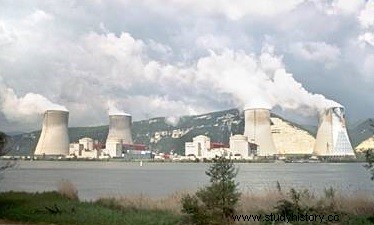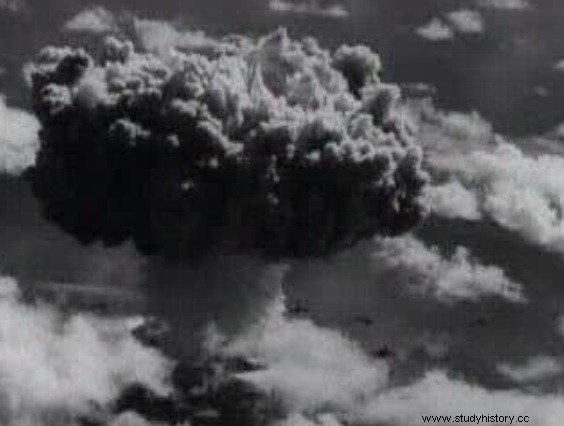 In the late 1930s, it was discovered that breaking atomic nuclei of uranium caused a reaction that released a energy incredible, capable of destroying all of humanity or generating electricity. Supported by a vast industry, nuclear has continued to develop since the 1970s. Today, approximately 15% of the electricity produced in the world is of nuclear origin, and in France, the proportion is 80%. This high-risk technology is still at the center of energy and even climate issues.
In the late 1930s, it was discovered that breaking atomic nuclei of uranium caused a reaction that released a energy incredible, capable of destroying all of humanity or generating electricity. Supported by a vast industry, nuclear has continued to develop since the 1970s. Today, approximately 15% of the electricity produced in the world is of nuclear origin, and in France, the proportion is 80%. This high-risk technology is still at the center of energy and even climate issues.
1945:the beginning of the "nuclear age"
No more coal, no more oil, no more white coal, the world will become an earthly paradise, unless..." Excerpt from a booklet published in Lyon by Édouard Jacquet at the end of 1945, this sentence, written after the explosions of the atomic bomb in Hiroshima and Nagasaki (August 6 and 9, 1945), illustrates the hopes and doubts aroused by nuclear power. Despite the destructive scope of the new weapon and the considerable media effect of the event, the opening of the "nuclear age" is characterized by the permanence of a double representation.
 In line with scientific research from the first half of the 20th century, this energy is thus associated with medical treatments ( fight against skin cancer from the 1920s). In addition, firms like Tho-Radia had popularized the image of positive radioactivity by introducing thorium and radium salts into beauty products, until they were banned in 1937. After the Second World War again , advertisers did not hesitate to use radioactivity to promote their products. The Zoé soda took its name from the first French atomic pile which diverged at Saclay on December 12, 1948. The bomb itself was not only associated with terror:the Bikini was named after the atoll in the Marshall Islands. which the United States was testing.
In line with scientific research from the first half of the 20th century, this energy is thus associated with medical treatments ( fight against skin cancer from the 1920s). In addition, firms like Tho-Radia had popularized the image of positive radioactivity by introducing thorium and radium salts into beauty products, until they were banned in 1937. After the Second World War again , advertisers did not hesitate to use radioactivity to promote their products. The Zoé soda took its name from the first French atomic pile which diverged at Saclay on December 12, 1948. The bomb itself was not only associated with terror:the Bikini was named after the atoll in the Marshall Islands. which the United States was testing.
This two-sided imaginary was anchored in the concrete prospects envisaged for nuclear power at least until the mid-1960s. The United States, which had carried out the first nuclear power under the code name Trinity l July 16, 1945 in New Mexico, did not long remain the only nuclear power. The Soviet Union in turn carried out a first test in August 1949. At the same time, the United Kingdom and France embarked on research which culminated in 1952 and 1960 respectively. A product of big science, the atomic bomb defined a “ club” of the nuclear powers. The multiplication of atmospheric tests had direct consequences in terms of pollution.
Early initiatives sought to limit this arms race (3,000 weapons in 1955, 37,000 a decade later):pacifist calls from personalities (manifesto Russell-Einstein in July 1955), sometimes not without ulterior motives (Stockholm appeal for peace in 1950), militant marches (from London to Aldermaston in the United Kingdom every year from 1958), non-proliferation treaty (1968). Nuclear energy was thus the first technology to arouse fears of the destruction of the world. In 1996, a moratorium on nuclear testing was introduced. It has since been violated by states acceding to atomic power (India, Pakistan, North Korea).
Next to the bomb, the atomic pile
As soon as the first experimental reactor was commissioned by Enrico Fermi's team (December 2, 1942) in Chicago, civil uses of nuclear energy were envisaged, not as derivatives of military usage, but with their own logic. Created in 1946, the Atomic Energy Commission studied these applications. Atomic propulsion, popularized by popular science journals, was in practice confined to a few civilian ships and military submarines (USS Nautilus, 1954). The atomic locomotives, cars and planes did not see the light of day. Similarly, the use of nuclear explosives for the drilling of canals, tunnels or the digging of ports was limited to a few dozen explosions (Plowshare project).
 Power generation became the dominant civilian use. At first, the United States imposed technological secrecy and then set out, after President Eisenhower announced the “Atoms for Peace” initiative (1953), to conquer the markets of the world, especially Europe. As early as 1951, electricity was produced from nuclear energy. The real industrial turning point came in 1954 with the construction of civil reactors entrusted to private manufacturers:Westinghouse for the pressurized water reactor in Shippingport (Pennsylvania) and General Electric for the boiling water reactor in Morris (Illinois).
Power generation became the dominant civilian use. At first, the United States imposed technological secrecy and then set out, after President Eisenhower announced the “Atoms for Peace” initiative (1953), to conquer the markets of the world, especially Europe. As early as 1951, electricity was produced from nuclear energy. The real industrial turning point came in 1954 with the construction of civil reactors entrusted to private manufacturers:Westinghouse for the pressurized water reactor in Shippingport (Pennsylvania) and General Electric for the boiling water reactor in Morris (Illinois).
Untreatable waste
In the USSR, the reactor of the world's first civilian power plant was commissioned in Obninsk in 1954, allowing the Soviet camp to present itself as the champion of the peaceful uses of atom. In Europe, the United Kingdom inaugurated its first reactor (Calder Hall) in 1956, a year before the United States. In France (Chinon, 1963), Germany, Spain, Sweden, Italy, Belgium, Switzerland..., various technologies were tested. France, with the natural uranium graphite gas sector (known as “UNGG”), developed by the Atomic Energy Commission (CEA), made its nuclear skills a long-term industrial project, capable of reducing energy dependence.
While most industrialized countries envisaged the construction of nuclear power plants in the 1960s, only a few implemented real development plans for civilian nuclear power (Spain, France), using American technologies. Upstream of the reactor, the supply of uranium therefore took on a strategic character, while downstream the radioactive waste became the symbol of the very long-lasting pollution caused by this energy.
Nuclear questioning
The anti-nuclear movement, anchored in the nebula of protests of previous decades, gained momentum in the 1970s with, as a high point, the demonstration against the Superphenix breeder reactor in July 1977. The forms of mobilization were varied, from peaceful demonstrations to attacks (Fessenheim and Creys-Malville in France, Lemoniz in Spain). Despite some successes, the movement did not acquire a size allowing it to weigh in electoral terms in Western democracies. The accidents (Three Mile Island in 1979, Chernobyl in 1986, Fukushima in 2011) led to a strengthening of safety standards by the nuclear industry, to the establishment of independent control authorities as well as to a resurgence of opposition demanding a moratorium (Italy) or the reduction of the nuclear share (Germany).
International bodies (International Atomic Energy Agency, 1957; OECD Nuclear Energy Agency, 1958; World Association of Nuclear Operators, Wano, 1989) are now seeking to reconcile geopolitical issues and industrial interests while reassuring populations.
To go further
- The Epic of Nuclear Power:A Scientific and Industrial History, by Paul Reuss. EDP Sciences, 2007.
- Le Nucléaire, by Cédric Lewandowski. What do I know, 2021.
